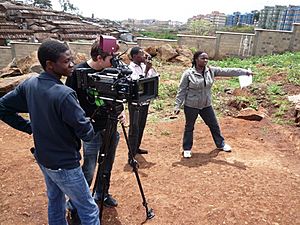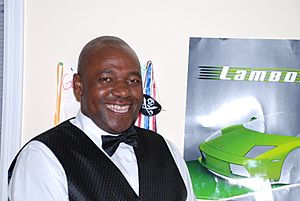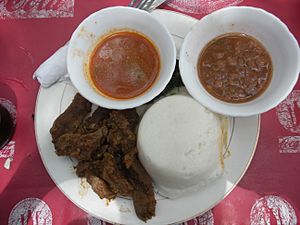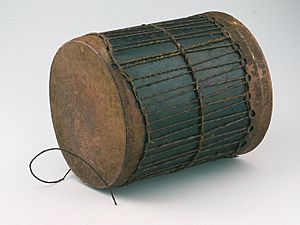Culture of Kenya facts for kids


The culture of Kenya is made up of many different traditions and new trends. Kenya doesn't have just one main culture. Instead, its cultural heritage and modern ways of life come from the many different communities living there.
However, some experts, like Professor Olubayi Olubayi, believe that a unique national culture is growing in Kenya. This culture borrows from and mixes with the country's many older ethnic cultures. This new national culture includes a shared language, a strong sense of being Kenyan, a successful government system, and popular multi-ethnic cultural events in cities.
Contents
Kenyan Food: A Taste of Diversity
Kenya has a wide variety of foods, and no single dish represents the whole country. Different communities have their own traditional meals. Common foods include maize and other grains like millet and sorghum. These are often eaten with different meats and vegetables.
Some foods are popular all over Kenya. These include ugali, sukuma wiki, and nyama choma. The food from Kenya's coast is also very special and well-liked.
What is Sukuma Wiki?
Sukuma wiki is a Swahili phrase that means "to push the week." It's a simple dish made with green leafy vegetables, similar to kale. It can also be made with leaves from cassava, sweet potato, or pumpkin plants. People often eat it to help their food last through the week.
Nyama Choma: Kenya's Favorite Grilled Meat
Nyama choma means "grilled meat." It's like Kenya's unofficial national dish! It's usually goat or sheep meat, grilled over an open fire. People often eat nyama choma with ugali and kachumbari (a fresh salad). It's also served with maharagwe (bean stew) and mchicha (shredded spinach). This meal is a tradition during Christmas Day.
Regional Dishes Across Kenya
In western Kenya, the Luhya enjoy ingokho (chicken) with ugali. They also eat other dishes like tsisaka and managu.
The Kalenjin in the Rift Valley have long made mursik, a fermented milk drink. They drink it with kimyet (ugali) and vegetable dishes.
The Kikuyu of Central Kenya eat many root vegetables. These include ngwaci (sweet potatoes), ndũma (taro root or arrowroot), ikwa (yams), and mianga (cassava). They also eat legumes like beans.
Around Lake Victoria, the Luo love kuon (ugali) and rech (fish). They also eat chicken, sun-dried meat, and various green vegetables.
Food changes as you travel across Kenya. People eat what is available locally. For example, communities that grow grains, like the Kikuyu, eat grains as their main food. People near the coast or lakes, like the Luo, eat more fish and seafood. In dry areas, foods made from sorghum are common.
In cities, working families often eat rice and stew. Other popular dishes include chapati, a flatbread similar to Indian paranthaj, and chicken stew.
National Dress: A Colorful Mix

Kenya does not have one single national dress that everyone wears. This is because Kenya has over 42 different ethnic groups, each with its own unique traditions and symbols. It has been hard to create one outfit that represents everyone. However, there have been efforts to design a national dress, similar to the Kente cloth of Ghana.
Kitenge and Kanga: Popular Fabrics
Kitenge is a cotton fabric with bright colors and designs made using special dyeing techniques. Many Kenyans wear Kitenge. Even though it's worn in many other African countries, it's mostly worn in Kenya for ceremonies and special events, not as an everyday official dress.
The Maasai wear dark red clothes. This color shows their love for the earth and how much they depend on it. It also stands for courage and the life given to them by nature.
The Kanga (also called Khanga or Lesso) is another popular cloth found in almost every Kenyan home. A Kanga is a piece of fabric about 1.5 meters by 1 meter. It has beautiful sayings in Swahili (or English) printed on it. Women often wear it wrapped around their waist and upper body.
Music: Rhythms of Kenya
Kenya has many different music styles. These include popular music from other countries, afro-fusion, benga music, and traditional folk songs. The guitar is very popular in Kenyan music, and songs often have complex guitar rhythms. Famous early musicians include Bonie Makie and Fadhili Williams, who wrote the hit song "Malaika."
In the 1980s and 1990s, popular Kenyan music had two main styles: the Swahili sound and the Congolese sound. Some musicians also created "hotel pop" for tourists, which sounded more like Western music. Them Mushrooms was a popular group from this time.
More recently, new types of modern popular music have appeared. These are often local versions of Western hip-hop. Two main styles are "Genge" and "Kapuka" beats. These styles have changed Kenyan music and are very popular with young people. There is also underground Kenyan hip-hop that focuses more on social issues. Early artists in this style include Poxi Presha and Kalamashaka.
Many popular Kenyan artists today include Nameless, Redsan, Nonini, and Suzzanna Owiyo. Their music ranges from Reggae and Ragga to Pop, Afro-Fusion, and Hip-Hop. Kenyan music is becoming well-known, with African music channels like Channel O and MTV Base helping it reach more people.
The Kisima Music Awards celebrate musical talent across East Africa. Many Kenyan artists win awards each year. The African Children's Choir also includes children from Kenya and other African countries.
Literature: Stories and Plays
The Kenya National Theatre helps a lot with literature by supporting local media personalities. Spoken word performances and stage acting are very important. Many Kenyan authors, like Ngugi wa Thiongo and Margaret Ogola, have written "set books" that are studied in Kenyan high schools. Their books often talk about Kenyan politics, social life, and modern lifestyles.
Art: Ancient and Modern Creations
Around Lake Turkana, you can find ancient rock carvings of people and animals. Bantu tribes still create funeral posts with carvings of human heads on top of geometric designs. The Kikuyu people also continue ancient traditions in the designs painted on their shields.
Media: Film and TV in Kenya
Film: Movies Made in Kenya and Beyond

The Kenyan government has started to support the film industry more. While few local films have been made, many foreign movies have been filmed in Kenya. Some famous examples include the award-winning The Constant Gardener and Nowhere in Africa.
Other well-known films set in Kenya include Karen Blixen's Out of Africa and Born Free. Kenyan film actors include Paul Onsongo and John Sibi Okumu.
The White Masai, a German movie about a Swiss woman who fell in love with a Maasai warrior, won an award in 2006. Rise and Fall of Idi Amin, about the Ugandan dictator, was filmed in Kenya and is considered a very successful movie made by a Kenyan director, Sharad Patel.
The Kenya Film Commission (KFC) was set up by the Kenyan government in 2005 to help the film industry grow.
Television: From Comedy to News

Acting for television has been popular in Kenya since the 1960s. Early actors like Mzee Pembe and Benson Wanjau (Ojwang' Hatari) became famous for their comedies in Swahili.
Serious TV dramas started in the early 1990s. Tushauriane, a Swahili TV series, was one of the most popular shows.
Later, stand-up comedy became popular. The group 'Redykyulass' became famous for their political jokes. They even made fun of the Kenyan President at the time, Daniel arap Moi. This was very new and brave, as such humor was not allowed before.
Today, many TV stations in Nairobi, like Nation TV, Kenya Television Network (KTN), and Citizen TV, show plays and other programs. K24, a newer station, became popular when Jeff Koinange, a well-known Kenyan journalist, became its main news anchor.
An African TV channel called A24 started broadcasting from Nairobi in 2008. It honors the famous Kenyan photojournalist, Mohamed Amin.
Theatre: Live Performances and Festivals

Kenya has an annual drama festival for schools and colleges. It brings together actors and students from all over the country. The Kenya National Theatre is in Nairobi. Popular theatre groups include Festival of Creative Arts and Phoenix Players.
Well-known actors in Kenyan theatre include Stella Awinja Muka and Liz Njaga. Famous directors include Tirus Gathwe, who is known for "taking Theatre to the people" by staging plays in different places across the country. Other notable directors are Carole Odongo and Nice Githinji.
Christmas in Kenya
Christmas is a public holiday in Kenya, celebrated on December 25th. Many Kenyans leave the cities and go to their rural hometowns to spend the whole month with their families until the New Year.
A very popular traditional Christmas meal in Kenya is nyama choma. This involves grilling meat, including beef, chicken, lamb, and goat.
On Christmas Eve, churches are full of people attending night vigils, called Kesha in Swahili. These often include nativity scenes. At midnight, church bells ring to mark the birth of Christ, and people sing carols to begin Christmas Day.
See also
- List of African cuisines
- List of ethnic groups of Kenya
- Sport in Kenya
Images for kids













